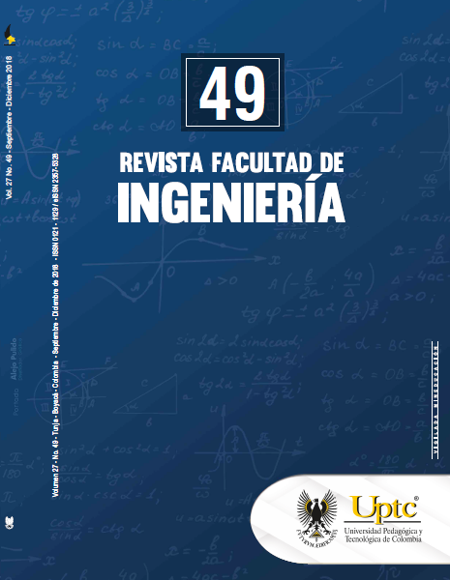Stress-strain and penetration characteristics of clay modified with crumb rubber

Abstract
Waste disposal has become a serious issue worldwide due to the huge amount of by-products generated by refineries and smelting industries that threat the environment if they are disposed inefficiently. Development of roads leads to a large usage of vehicles and, hence, a large amount of rubber waste (i.e., from tyres). Given that storing this material pollutes the environment, its recycled reused is currently trending. Various percentages of crumb rubber (0, 10, 15, 20, 30, 40 and 50) were mixed with highly and low compressible clay to understand the strength and penetration characteristics of the modified clay. Additionally, the thickness reduction of the pavement layer that reduces construction costs was visualize.
Keywords
bearing, clay, crumb rubber, strength
References
[1] M. Lalatendu, “Turning waste tyre into ‘green steel,’” The Hindu, 2016. [Online]. Available: https://www.thehindu.com/business/Turning-waste-tyre-into-‘green-steel’/article14518524.ece.
[2] W. Cao, “Study on properties of recycled tire rubber modified asphalt mixtures using dry process,” Constr. Build. Mater., vol. 21(5), pp. 1011–1015, 2007. DOI: https://doi.org/10.1016/j.conbuildmat.2006.02.004.
[3] A. F. Cabalar, Z. Karabash, R. Cabalar, and A. F. Karabash, “California Bearing Ratio of a Sub-Base Material Modified With Tire Buffings and Cement Addition California Bearing Ratio of a Sub-Base Material Modified With Tire,” J. Test. Eval., vol. 43(6), pp. 1279–1287, 2015. DOI: https://doi.org/10.1520/JTE20130070.
[4] M. Tajdini, A. Nabizadeh, H. Taherkhani, and H. Zartaj, “Effect of Added Waste Rubber on the Properties and Failure Mode of Kaolinite Clay,” Int. J. Civ. Eng., vol. 15(6), pp. 949–958, 2017. DOI: https://doi.org/10.1007/s40999-016-0057-7.
[5] S. M. Anvari, I. Shooshpasha, and S. S. Kutanaei, “Effect of granulated rubber on shear strength of fine-grained sand,” J. Rock Mech. Geotech. Eng., vol. 9(5), pp. 936–944, 2017. DOI: https://doi.org/10.1016/j.jrmge.2017.03.008.
[6] S. Bali Reddy, D. Pradeep Kumar, and A. Murali Krishna, “Evaluation of the Optimum Mixing Ratio of a Sand-Tire Chips Mixture for Geoengineering Applications,” J. Mater. Civ. Eng., vol. 28(2), p. 06015007, 2015. DOI: https://doi.org/10.1061/(ASCE)MT.1943-5533.0001335.
[7] P. J. Bosscher, T. B. Edil, and S. Kuraoka, “Design of Highway Embankments Using Tire Chips,” J. Geotech. Geoenvironmental Eng., vol. 123(4), pp. 295–304, 1997. DOI: https://doi.org/10.1061/(ASCE)1090-0241(1997)123:4(295).
[8] J. H. Lee, R. Salgado, A. Bernal, and C. W. Lovell, “Shredded tires and rubber-sand as lightweight backfill,” J. Geotech. Geoenvironmental Eng., vol. 125(2), pp. 132–141, Feb. 1999. DOI: https://doi.org/10.1061/(ASCE)1090-0241(1999)125:2(132).
[9] A. Srivastava, S. Pandey, and J. Rana, “Use of shredded tyre waste in improving the geotechnical properties of expansive black cotton soil,” J. Geomech. Geoengin., vol. 9(4), pp. 303–311, Apr. 2014. DOI: https://doi.org/10.1080/17486025.2014.902121.
[10] H. Moo-young, K. Sellasie, D. Zeroka, and G. Sabnis, “Physical and Chemical Properties of Recycled Tire Shreds for Use in Construction,” vol. 129(4), pp. 921–929, 2003.
[11] J. G. Zornberg, A. R. Cabral, and C. Viratjandr, “Behaviour of tyre shred - sand mixtures,” Can. J. Civ. Eng., vol. 41(2), pp. 227–241, 2004. DOI: https://doi.org/10.1139/T03-086.
[12] S. Akbulut, S. Arasan, and E. Kalkan, “Modification of clayey soils using scrap tire rubber and synthetic fibers,” Appl. Clay Sci., vol. 38(1–2), pp. 23–32, 2007. DOI: https://doi.org/10.1016/j.clay.2007.02.001.
[13] H. Cetin, M. Fener, and O. Gunaydin, “Geotechnical properties of tyre- cohesive clayey soil mixtures as a fill material,” Eng. Geol., vol. 88(1–2), pp. 110–120, 2006. DOI: https://doi.org/10.1016/j.enggeo.2006.09.002.
[14] M. Tajabadipour, and M. Marandi, “Effect of rubber tire chips-sand mixtures on performance of geosynthetic reinforced earth walls,” Period. Polytech. Civ. Eng., vol. 61(2), pp. 322–334, 2017. DOI: https://doi.org/10.3311/PPci.9539.
[15] J. S. Yadav, and S. K. Tiwari, “Influence of crumb rubber on the geotechnical properties of clayey soil,” Environ. Dev. Sustain., vol. 20 (6), pp. 2565–2586, 2018.
[16] J. S. Yadav, and S. K. Tiwari, “Effect of inclusion of crumb rubber on the unconfined compressive strength and wet-dry durability of cement stabilized clayey soil,” J. Build. Mater. Struct., vol. 3, pp. 68–84, 2016.
[17] D. N. Humphrey, T. C. Sandford, M. M. Cribbs, and W. P. Manion, “Shear Strength and Compressibility of Tire chips for Use as Retaining Wall Backfill,” Transportation Research Record 1422, TRB, National Research Council, Washington. D.C. pp. 29–35, 1993.
[18] T. B. Edil, P.J. Fox, and S. W. Ahl, “Hydraulic Conductivity and Compressibility of Waste Tire Chips,” In Procceeding of 15th Annual Madison Waste Conference, 1992, pp. 49–61.
[19] V. O’Shaughnessy, and V. K. Garga, “Tire-reinforced earthfill. Part 3: Environmental assessment,” Can. J. Civ. Eng., vol. 37(1), pp. 117–131, 2000. DOI: https://doi.org/10.1139/t99-086.
[20] P. Hennebert, S. Lambert, F. Fouillen, and B. Charrasse, “Assessing the environmental impact of shredded tires as embankment fill material,” Can. J. Civ. Eng., vol. 51(5), pp. 469–478, 2014. DOI: https://doi.org/10.1139/cgj-2013-0194.
[21] A. Al-Tabbaa, O. Blackwell, and S. A. Porter, “An Investigation into the Geotechnical Properties of Soil-Tyre Mixtures,” Environ. Technol., vol. 18(8), pp. 855–860, 2010. DOI: https://doi.org/10.1080/09593331808616605.
[22] S. Gacke, M. Lee, and N. Boyd, “Field Performance and mitigation of shredded tire embankment,” Transp. Res. Rec., vol 1577, pp. 81–89, 1997. DOI: https://doi.org/10.3141/1577-10.
[23] B. Ajmera, B. Tiwari, and J. Koirala, “Geotechnical Properties of Clays Modified with Recycled Crumb Rubber,” In Geotechnical and Structural Engineering Congress, 2016, pp. 14–17.
[24] Bureau of Indian Standards, IS 2720(Part III/2) Determination of Specific Gravity for fine, medium and coarse grained soil, 1997, pp. 1–10.
[25] Bureau of Indian Standard, IS 2720 (Part IV) Grain size analysis, 1995, pp. 1–40.
[26] Bureau of Indian Standard, IS 2720 (Part V) Determination of Liquid and Plastic Limit, 1995, pp. 1–17.
[27] Bureau of Indian Standard, IS 2720 (Part VI) Determination of Shrinkage Factors, 2001, pp. 1–20.
[28] Bureau of Indian Standard, IS 1498 Classification and Identification of Soils for General Engineering Purpose, 2002, pp. 1–28.
[29] Bureau of Indian Standards, IS 2720 (Part X) Determination of Unconfined Compressive Strength, 1995, pp. 1–8.
[30] Bureau of Indian Standard, IS 2720 (Part 16) Laboratory Determination of CBR, 1997, pp. 1–17.
[31] A. Singh, Soil Engineering in Theory and Practice. Bombay, India: Asia Publishing House, 1967.